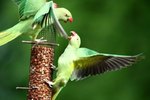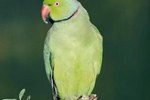
Indian ringneck parakeets (Psittacula krameri manillensis), aka rose-ringed parakeets and ring-necked parakeets, are among four subspecies of ringneck parakeets. Indian ringnecks are arguably the most encountered ringnecks outside of their natural range. Like other birds, these specimens require certain features in their captive habitats. The species is particularly adaptable -- which has caused alarm as feral, invasive populations grow across the world. As of 2013, it is illegal to own a ringneck or any other exotic bird species.
Native Range
Ringneck parakeet species are native to a wide span of tropical areas stretching from west Africa throughout India and south of the Himalayas. The Indian ringneck parakeet, the most common subspecies kept in captivity, originated in Sri Lanka. The species' range now includes Pakistan, Afghanistan, Nepal, southern Vietnam and India.
Native Habitat
In their native Sri Lanka, India and surrounding regions, these apple-green birds originally took up residence in the semiarid forests or wooded areas. However, this subspecies has proved quite adaptable, thriving in human-inhabited areas including farms, urban areas, suburban areas and agricultural areas, anywhere with nesting sites and a food source.
Habitat in the Wild
Like other birds, Indian ringneck parakeets inhabit areas that provide suitable nesting sites and constant supply of food and water. Preferred nesting sites are often tree cavities, which are found in abundance in urban, suburban and rural areas. Indian ringnecks dine on a variety of plant materials -- berries, fruits, nuts, grains, seeds and flowers -- making them able to eat in any arable location. Their varied diet makes them considerable pests in some areas of both their native range and those where they have been introduced.
Introduced Ranges and Habitats
The medium-size Indian ringneck's adaptability has allowed the species to become established in other areas of the world. The creature is sometimes considered an invasive or destructive species. Areas of Indian ringneck populations in the United States include Florida, California and Hawaii. This species has become established in several European countries and in Africa, Japan, Australia and the Middle East. Despite the birds' native range, this species has adapted to cold winters in Britain due to the ample supply of food.
Captive Habitats
The smart, playful Indian ringneck parrots require large cages, preferably aviaries where they have room to fly. If an aviary is out of the question, choose the largest cage you can fit in your home, but make sure it's at least 3 feet tall by 2 feet wide and 1 1/2 feet deep. Because they're so active, smart and inquisitive, these colorful birds need a large variety of toys. Rotate toys on a schedule to help keep them entertained.
References
Resources
Photo Credits
-
Dan Kitwood/Getty Images News/Getty Images
Writer Bio
With a professional background in gardening, landscapes, pests and natural ecosystems, Jasey Kelly has been sharing her knowledge through writing since 2009 and has served as an expert writer in these fields. Kelly's background also includes childcare, and animal rescue and care.




